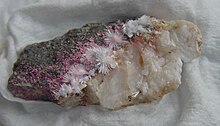| Picropharmacolite | |
|---|---|
 Picropharmacolite with guerinite and erythrite from Bauhaus, Hesse, Germany. Specimen size 5.5 cm | |
| General | |
| Category | Arsenate mineral |
| Formula (repeating unit) | Ca4Mg(AsO3OH)2(AsO4)2·11H2O |
| IMA symbol | Ppm[1] |
| Strunz classification | 8.CH.15 |
| Dana classification | 39.2.4.1 |
| Crystal system | Triclinic |
| Crystal class | Pinacoidal (1) (same H-M symbol) |
| Space group | P1 |
| Unit cell | a = 13.547 Å, b = 13.5 Å, c = 6.71 Å; α = 99.85°, β = 96.41°, γ = 91.6°; Z = 2 |
| Identification | |
| Formula mass | 940.48 g/mol |
| Color | White or colorless |
| Crystal habit | As prismatic crystals more typically in radial aggregates, globular crusts, and fibrous concretions |
| Twinning | None reported |
| Cleavage | Perfect on {100} and {010} |
| Fracture | Micaceous |
| Tenacity | Fragile |
| Mohs scale hardness | 1 to 2 |
| Luster | Silky, slightly pearly |
| Streak | White |
| Diaphaneity | Translucent to opaque |
| Specific gravity | 2.58 - 2.60 |
| Optical properties | Biaxial (+) |
| Refractive index | nα = 1.631, nβ = 1.632, nγ = 1.640[2] or nα = 1.557, nβ = 1.566 – 1.571, nγ = 1.577 – 1.579[3] |
| Birefringence | δ = 0.009 |
| 2V angle | 40° – 50° |
| Dispersion | r < v strong |
| Other characteristics | Fluorescent blue-white under long wave and short wave ultraviolet light |
| References | [2][3][4][5] |
Picropharmacolite, Ca4Mg(AsO3OH)2(AsO4)2·11H2O, is a rare arsenate mineral. It was named in 1819 from the Greek for bitter, in allusion to its magnesium content, and its chemical similarity to pharmacolite. The mineral irhtemite, Ca4Mg(AsO3OH)2(AsO4)2·4H2O, has the same composition as picropharmacolite, except that it has only four water molecules per formula unit, instead of eleven. It may be formed by the dehydration of picropharmacolite.
- ^ Warr, L.N. (2021). "IMA–CNMNC approved mineral symbols". Mineralogical Magazine. 85 (3): 291–320. Bibcode:2021MinM...85..291W. doi:10.1180/mgm.2021.43. S2CID 235729616.
- ^ a b Gaines et al (1997) Dana's New Mineralogy Eighth Edition, Wiley
- ^ a b http://rruff.geo.arizona.edu/doclib/hom/picropharmacolite.pdf Handbook of Mineralogy
- ^ "Picropharmacolite".
- ^ "Picropharmacolite Mineral Data".